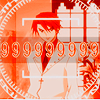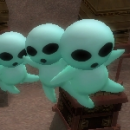The biggest mistake that literalists (here: those who deny the evidence on TMC's pre-OoT placement) make is that they simply refuse to imagine for a second what would be if TMC was confirmedly the first game. Please assume it was confirmed as truth - and then look at all the quotes pointing towards it: How could you still seriously claim those were a bad way to convey the developer's intention?
Now if you return to reality where TMC is not confirmed to be first, the evidence *still* point towards it being so. Perfect.
Yeah, this is often the problem with a lot of all but confirmed theories. The fact is, anyone would read TMC's ending (in any non-English speaking country) and think that means it's the first game, provided they know there are many Links. Anyone would read ALttP's box and think that means it's the first game, too.
A few minor points:
The Forest Picori figurine states that the Picori “delight in making humans happy by hiding helpful items and Rupees under grass and rocks all over the world.” This occurrence is something that would obviously take place before every other game.
Similarly, the Armos figurine tells us that they were “built by the Minish for the Wind Tribe long ago”.
Of course, these could be perceived to be totally irrelevant since they're not part of the main story, but they ARE given context (unlike Triumph Forks), and they fit with basically everything else in the game: A telling of Hyrule's history. As Bill Trinen said, delving into "Hylian lore".
Hyrule is very different to that seen in the other games. It's either a different part of Hyrule - my suggestion being to the east of OoT's, since Mt. Crenel = Death Mountain, or it's a rotation with a few things from other games we can't see and a few things (like the Minish Woods) that aren't in other games. The rotation works like this:
 Minish_Cap_Rotated.PNG 133.56K
17 downloads
Minish_Cap_Rotated.PNG 133.56K
17 downloadsA few things fit ALttP's map there... The swamp area could actually be the future Lost Woods. This might be unintentional, but the other story elements in TMC certainly aren't.
Edit: I'm an idiot for only just realising this, because I've looked at this map loads of times, but the Minish Woods might turn into the somewhat foresty southern area of ALttP's Hyrule (which isn't really in what we see of OoT's Hyrule), and then the desert would be to the west somewhere. Obviously Lake Hylia fits, so this might work better than I thought. The graveyard fits with ALttP, too. >_>
It's also significant because so many places have different names to in other games. Mt. Crenel only makes sense long before or long after other games, and considering FSA has Death Mountain again with no explanation, and considering all the other hints in the game to Hyrule's history, it corroborates nicely. I really do think it's necessary for a lot of time to pass between TMC and FSA, for the Hylians to disappear and for the common names of things to be adopted.
Also, basically any references to TWW are irrelevant, because even the game's director said that elements from other games were added long after they had created the world of TMC. And Flagship come up with the stories for the Capcom games (the Oracles had their scenarios planned before their gameplay), so it's a bit different to how Nintendo does it, right? TMC's director said "We created the world of the Minish Cap first, then chose characters to fit this world."
The Ending can make plenty of sense regardless of it's timeline placement. In my opinion, TMC being the beginning only introduces plot holes (and since I had TMC as first in my timeline for over a year, I know what I'm talk about) and frankly, it's not worth the trouble just for a couple of vague ass lines with barely any context whatso-fucking-ever.
...Barely any context? Seriously? What about the context of the ENTIRE GAME? What about the very final event of the entire game before the credits (which is all about emphasising the hat)? You can't say that a game's ENDING lacks context. Triumph Forks lack context. I can't think of ANY evidence for post-TWW that exists in the actual story of TMC, which is what I made this topic to hear. I know that the ending still makes sense to you with your timeline, but as Jumbie said, that's because you've reinterpreted from the perspective of your timeline. What I'm saying is that the logical conclusion is that TMC is first, particularly as there's a lot of evidence to fit it. So what are these plotholes? They would have to be something IN TMC, I hope. And no, Link's clothes aren't a plothole.
It was never "in development", but there were plans for it on the drawing board. Can you fetch this Aonuma statement? Because I never heard this.
Even if you were right, this says NOTHING about a TMC sequel, and only implied an FS sequel. And
you're wrong.Actually, the interview that I was talking about a DS Zelda and Four Swords, I was explaining that with Four Swords we worked with two screens, and because of the experience we had with working with two screens we could easily adapt a system like that with the DS and do different things with it. But I never said that we were actually developing Four Swords for the DS.
At least, I think that's what it's referring to, and in any case it proves that (very unfortunately, because he's right, it works PERFECTLY!) Four Swords DS never existed. I also read in another interview that what he meant was that the FSA team was working on it, and that was misunderstood. Also, right below that question, do you see the picture of the interviewer, Aonuma, and another person to the left of him? The guy on the left is translating for Aonuma. His name is Bill Trinen, and he said that TMC was a look into Hylian lore (something also implied by the game's director in another interview), and that it's "the story of how Link gets his cap". Wouldn't you assume that this information came from the higher-ups, considering how often he hears everything they say?
Oh please. You can't deny the OBVIOUS implication that the Kokiri thing was the start of the Link uniform. That's just silly.
You're denying obvious implications in TMC, too. The Kokiri thing isn't an in-game explanation as to why most Links wear the green tunic, and it's not the real life reason either. And even the Kokiri clothes arguably had to come from somewhere... No real significance was placed on the clothes in OoT, while it was in TMC. You seemed to be arguing this from a plot point of view, not an intent point of view, and if you're now changing to the latter, you also have to accept TMC's intent.
I get the hat argument. I know it's symbolic. I don't give a shit, because OOT already explained where the hat came from. Two guys not wearing a hat is hardly much evidence for anything; the first hero even had a damned beard.
All this suggests is that you claim to understand, because your last two sentences are a non-sequitur from your first two. OoT didn't "explain where the hat came from", and even if it did, TMC has replaced it in that. OoT explained where the hat that three Links wear came from in STORY terms, that's unrelated to the symbolism in TMC. You're speaking on two different levels that don't really relate to each other here. TMC's Link was the first hero to wear a hat, that's the point being made.
Edited by Impossible, 24 March 2008 - 05:33 PM.




















